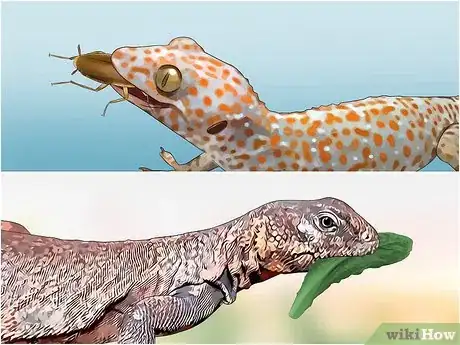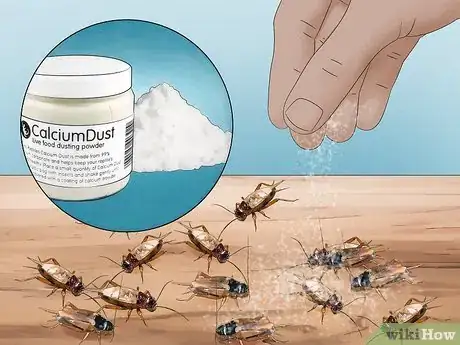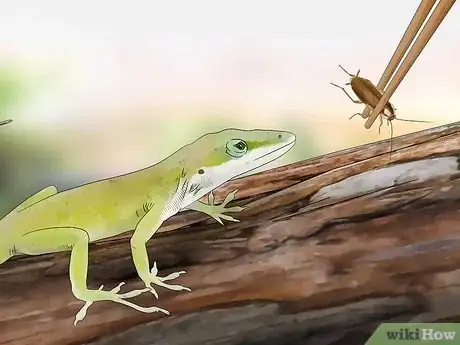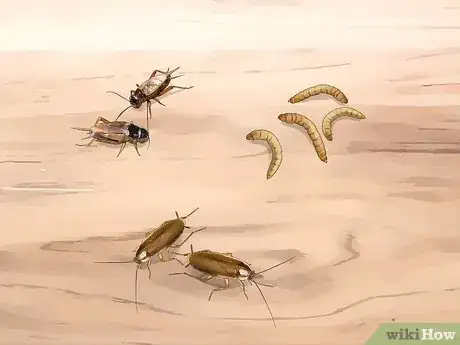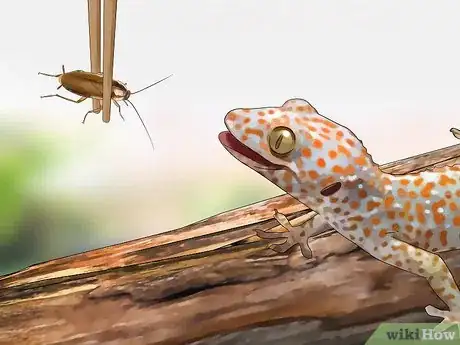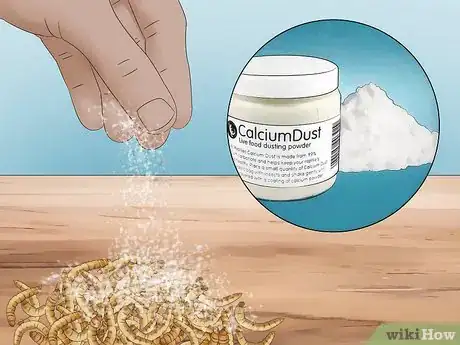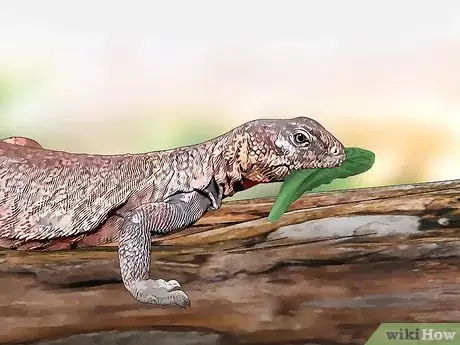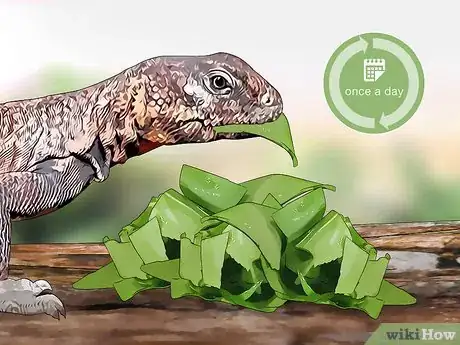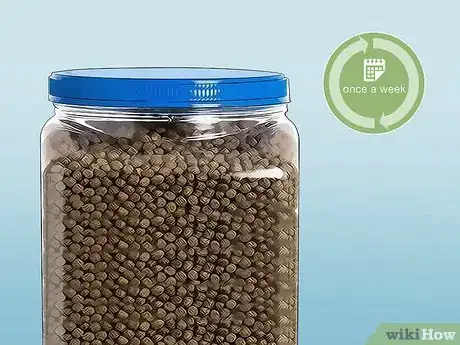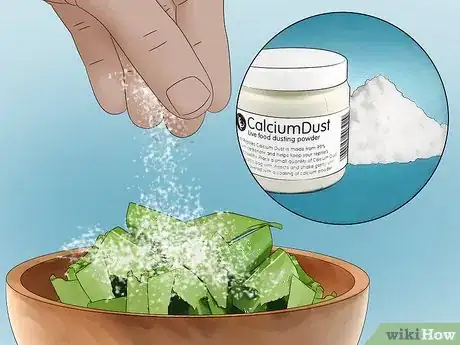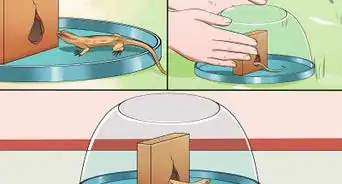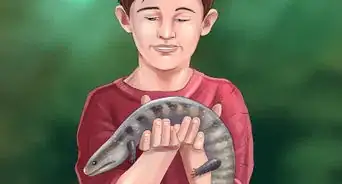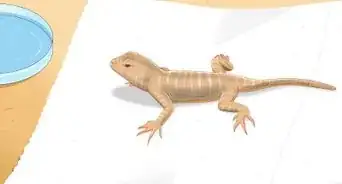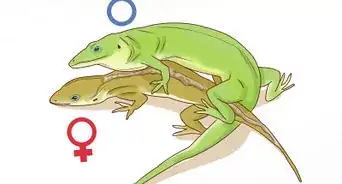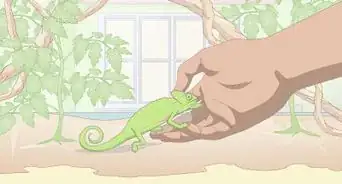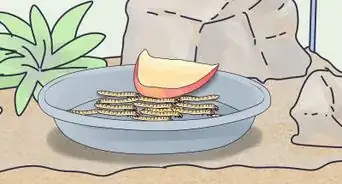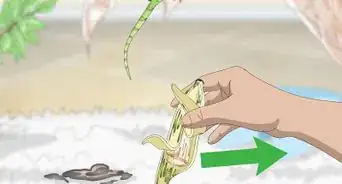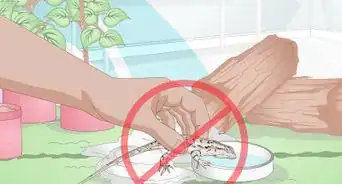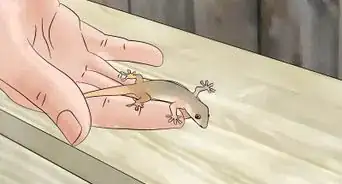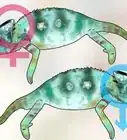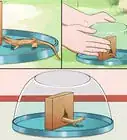This article was co-authored by Lauren Baker, DVM, PhD. Dr. Lauren Baker is a Veterinarian and Assistant Scientist at the University of Wisconsin-Madison. With over 10 years in veterinary medicine, she specializes in the concept of “one health,” which uses insights from veterinary medicine to help human medical research. She holds a Ph.D. in Comparative Biomedical Sciences, a Doctor of Veterinary Medicine, an MS in Comparative Biomedical Sciences, and a Bachelor’s degree in Psychology from the University of Wisconsin-Madison.
This article has been viewed 141,653 times.
If you have a lizard, you need to figure out how to feed it correctly to keep it healthy and active. First, you need to figure out what type of lizard you have by looking at its physical characteristics. Then, you can do a bit of online research to figure out what type of lizard you have and what type of food it should eat. In order to feed it properly, you will then need to know how you should give the food to your lizard and how much your lizard should be eating.
Steps
Determining the Right Diet For Your Lizard
-
1Identify the lizard. Different lizards eat different things. In order to feed your lizard properly, you need to know what type it is. Assess the physical characteristics of your lizard and write them down. Then you can use an identification guide or look up images of different types of lizards online using those characteristics. For example, you can use an online search engine to search for "lizard green spotted tail" and see if you find images of lizards that look like yours.[1]
- Some physical characteristics you can use to determine a type of lizard include size, color, pattern, and body shape. You should also think about changes in pattern or color on different parts of your lizard's body.
- You can also take your lizard to a pet store and ask an employee to help you identify it.
-
2Obtain the appropriate food for your lizard. Once you figure out what type of lizard you have, you will be able to research what type of food it eats. For example, anole green lizards should be fed small to medium live insects, every 2-3 days and geckos will eat meal worms, wax worms, crickets, and roaches.
- If you can't seem to figure out what type lizard you have, reach out to an expert. Ask your local veterinarian if they are comfortable with lizards, or if they know someone who is. You can also look for local or online herpetology groups that may be able to help you. It’s important that you identify the type of lizard you have because many species have very specific nutritional requirements and will get sick if you do not properly meet their needs.
Advertisement -
3Figure out how much and how often you should feed your lizard. In addition to knowing what type of food to give your lizard, you need to know how much and how often to give them food. Feeding your lizard the right amount is key to keeping it healthy and happy.
- Do some research online and figure out how much to feed your lizard. Internet research can give a base line of where to start with feeding and then you can adjust based on your specific lizard.
Feeding Anole Green Lizards
-
1Provide your anole with crickets. One of the meals that anoles enjoy the most is crickets and they can provide most of the nutrients an anole needs. Thus, when caring for anoles, crickets will make up the majority of your lizard's diet.
- Buy the smallest crickets offered at your pet store. If there is only "one size" available at a pet store, go to a different one. Anoles need to be given small crickets.
-
2Dust the crickets. You will need to add supplement powder to the crickets at each feeding to help ensure the anoles get enough calcium and vitamins. Anoles are missing some key nutrients and can get metabolic bone disease (MBD) and die if they are not given supplements.
- If you keep crickets around in bulk, "gut-load" them by feeding them a vitamin rich cricket food prior to feeding them to your lizards. This way, all of the nutritious food your crickets just ate will then, in turn, be passed on to your anole.
- Equally, if your crickets are starved, your anole soon will be too.
-
3Give your lizard different prey occasionally. In addition to crickets, anoles like small cockroaches or flies once in a while. This varies their diet and gives them some much needed exercise.
- Anoles may also eat waxworms, fruit flies, small worms, canned crickets, or earthworms.
-
4Don't leave uneaten crickets in your lizard's tank. Unless it's feeding time, the anole's food should be kept away from it when the lizard sleeps. This way the "leftovers" won't munch on your lizard while it's asleep. You may not expect it but medium to large crickets can eat the anole's extremities.
- If the crickets are small enough, they probably won't bother your anole. However, some owners of anoles advise to never release or leave crickets loose in the tank with the lizard. Rather to place them in a separate container, move the anole to the container for 5–10 minutes to eat, and then move the anole back to his tank when done.
Feeding Leopard Geckos
-
1Give your geckos a diet of insects. When caring for leopard geckos, you should feed them meal worms, wax worms, crickets, and roaches. These all make good food, however, most geckos' diets consist largely of crickets with other insects given occasionally.[2]
- Make sure to refrigerate the mealworms, as they turn into beetles if left at room temperature.
-
2Feed your gecko daily. Place as much of the food in the tank as your gecko can eat in 15 minutes. Don't leave crickets hopping around all day, as they will feed on your gecko if left in the lizard's tank too long.[3]
- The number of insects that your gecko will be able to eat in 15 minutes will vary, depending on your lizard's size, age, and appetite. Over time, as you get to know your lizard, you will learn how many insects to feed it.
-
3Gut load crickets. To give your lizard more nutrition, it is important to feed the crickets a lot before they are fed to your lizard. This is called "gut-loading" and is done by feeding your crickets nutritious foods, such as oats, fruit, and vegetables.[4]
- When you feed crickets highly-nutritious foods, that nutrition is passed on to your lizard. On the other hand, when you feed your lizard crickets that have malnutrition, your lizard will not get enough nutrition.
-
4Powder the feeding insects. Once a week sprinkle the insects you are feeding to your lizard with calcium and vitamin D powder. This is very important to ensure bone health, as well as general health. If your gecko is not given calcium and vitamin D powder, it could get a painful metabolic bone disease.[5]
- To coat the crickets, put them in a plastic bag with the supplement powder. Shake it up gently until the insects are completely covered. They should be totally white when sufficiently coated.
Feeding Uromastyx Lizards
-
1Provide your Uromastyx lizard with dark, leafy greens. One of the best parts about caring for Uros is that they eat foods that can be picked up from the grocery store. Adult Uros will eat a variety of dark leafy greens, including bok-choy, collard greens, dandelion greens, mustard and turnip greens, escarole, endive, and radicchio.[6]
- Your lizard may have particular favorites. Give them a mixture to choose from and then see which type of greens get eaten the most.
-
2Avoid calcium-blocking and nutrient-lacking greens. There are some dark leafy greens, such as kale and spinach, that contain many oxalates, which are salts or organic compounds of oxalic acid. These oxalates can interfere with calcium absorption. They should be fed minimally. Also, do not feed Uros Romaine or iceberg lettuce.[7]
- Lettuce has very little nutritional value. However, it does hydrate a lizard.
-
3Feed your lizard greens once a day. Cut up whatever dark, leafy greens your lizard prefers and place them in a small bowl. Your lizard's food should look like a nice chopped salad.[8]
- Use a bowl that is shallow enough so that the lizard can see the food if it is standing on the ground.
- Remove uneaten greens daily. Also clean out the bowl before refilling it the next day.
-
4Give your lizard pellets or seeds once a week. In addition to eating leafy greens, giving your lizard a few other foods will balance out its diet well. You can feed your lizard iguana pellets or tortoise food, whichever your lizard prefers. Uromastyx lizards also love seeds, including bird seed mixes and dried lentils.[9]
- Pellets and seeds should not make up the majority of your lizard's diet.
-
5Put supplements on your lizard's food weekly. Sprinkle a small amount of calcium dust onto the lizard's food to supplement it. You should also put a small amount of multivitamin dust on its food as well. This will help your lizard's overall health.[10]
- There are several types of calcium dusts available for purchase. If the lizard gets a lot of sunshine or UVB light, then you can use the outdoor version. If it is largely out of the sunlight and UVB, then you should use the indoor type.
Expert Q&A
-
QuestionCan I feed my lizard 4 bugs each day?
 Lauren Baker, DVM, PhDDr. Lauren Baker is a Veterinarian and Assistant Scientist at the University of Wisconsin-Madison. With over 10 years in veterinary medicine, she specializes in the concept of “one health,” which uses insights from veterinary medicine to help human medical research. She holds a Ph.D. in Comparative Biomedical Sciences, a Doctor of Veterinary Medicine, an MS in Comparative Biomedical Sciences, and a Bachelor’s degree in Psychology from the University of Wisconsin-Madison.
Lauren Baker, DVM, PhDDr. Lauren Baker is a Veterinarian and Assistant Scientist at the University of Wisconsin-Madison. With over 10 years in veterinary medicine, she specializes in the concept of “one health,” which uses insights from veterinary medicine to help human medical research. She holds a Ph.D. in Comparative Biomedical Sciences, a Doctor of Veterinary Medicine, an MS in Comparative Biomedical Sciences, and a Bachelor’s degree in Psychology from the University of Wisconsin-Madison.
Veterinarian How many bugs you should feed your lizard depends heavily on the size and species of your lizard, as well as the size of the bug. You should let your lizard decide by giving them several bugs and seeing how many they eat within 15 minutes.
How many bugs you should feed your lizard depends heavily on the size and species of your lizard, as well as the size of the bug. You should let your lizard decide by giving them several bugs and seeing how many they eat within 15 minutes. -
QuestionAre lizards born alive?
 Lauren Baker, DVM, PhDDr. Lauren Baker is a Veterinarian and Assistant Scientist at the University of Wisconsin-Madison. With over 10 years in veterinary medicine, she specializes in the concept of “one health,” which uses insights from veterinary medicine to help human medical research. She holds a Ph.D. in Comparative Biomedical Sciences, a Doctor of Veterinary Medicine, an MS in Comparative Biomedical Sciences, and a Bachelor’s degree in Psychology from the University of Wisconsin-Madison.
Lauren Baker, DVM, PhDDr. Lauren Baker is a Veterinarian and Assistant Scientist at the University of Wisconsin-Madison. With over 10 years in veterinary medicine, she specializes in the concept of “one health,” which uses insights from veterinary medicine to help human medical research. She holds a Ph.D. in Comparative Biomedical Sciences, a Doctor of Veterinary Medicine, an MS in Comparative Biomedical Sciences, and a Bachelor’s degree in Psychology from the University of Wisconsin-Madison.
Veterinarian This depends on the species of lizard. For example, skinks and jackson’s chameleons are ovoviviparous, meaning they incubate eggs inside their body and give birth to live young. In general, lizards do not give birth to live young as mammals do.
This depends on the species of lizard. For example, skinks and jackson’s chameleons are ovoviviparous, meaning they incubate eggs inside their body and give birth to live young. In general, lizards do not give birth to live young as mammals do.
Warnings
- Avoid feeding lizards in the wild. It will encourage them to see humans as friends, and some humans are not so friendly. If you let lizards keep their fear of humans, they can better avoid people that will hurt them.⧼thumbs_response⧽
References
- ↑ http://snr.unl.edu/herpneb/lizard/lizardidentificationkey.asp
- ↑ http://www.lihs.org/files/caresheets/E_macularius.htm
- ↑ http://www.lihs.org/files/caresheets/E_macularius.htm
- ↑ http://www.lihs.org/files/caresheets/E_macularius.htm
- ↑ http://www.lihs.org/files/caresheets/E_macularius.htm
- ↑ http://www.reptilesmagazine.com/Care-Sheets/Uromastyx-Lizard/
- ↑ http://www.reptilesmagazine.com/Care-Sheets/Uromastyx-Lizard/
- ↑ http://www.reptilesmagazine.com/Care-Sheets/Uromastyx-Lizard/
- ↑ http://www.reptilesmagazine.com/Care-Sheets/Uromastyx-Lizard/
About This Article
To feed a lizard, start by determining the exact lizard breed you have, since they have different types of diets. If you have an anole green lizard, feed it crickets dusted with a powdered vitamin supplement. Leopard geckos also like crickets, which you can feed them every day, and you can give them meal worms, wax worms, and roaches on occasion. If you have a uromastyx lizard, they prefer dark, leafy greens like bok-choy, collard greens, and dandelion greens every day and commercial pellets once per week. For tips on administering crickets, read on!

